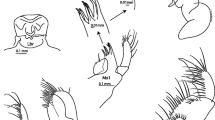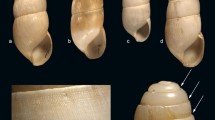Abstract
Bufonid toads of the genus Melanophryniscus represent one of several lineages of anurans with the ability to sequester alkaloids from dietary arthropods for chemical defense. The alkaloid profile for Melanophryniscus stelzneri from a location in the province of Córdoba, Argentina, changed significantly over a 10-year period, probably indicating changes in availability of alkaloid-containing arthropods. A total of 29 alkaloids were identified in two collections of this population. Eight alkaloids were identified in M. stelzneri from another location in the province of Córdoba. The alkaloid profiles of Melanophryniscus rubriventris collected from four locations in the provinces of Salta and Jujuy, Argentina, contained 44 compounds and differed considerably between locations. Furthermore, alkaloid profiles of M. stelzneri and M. rubriventris strongly differed, probably reflecting differences in the ecosystem and hence in availability of alkaloid-containing arthropods.








Similar content being viewed by others
References
Ayer, W. A. and Browne, L. M. 1977. The ladybug alkaloids including synthesis and biosynthesis. Heterocycles 7:685–707.
Bevins, C. L. and Zasloff, M. 1990. Peptides from frog skin. Annu. Rev. Biochem. 59:395–414.
Bonanseal, M. I. and Vaira, M. 2007. Geographic variation of the diet of Melanophryniscus rubriventris (Anura: Bufonidae) in northwestern Argentina. J. Herpetol., in press.
Cardall, B. L., Brodie, E. D. Jr., Brodie, E. D. III, and Hanifin, C. T. 2004. Secretion and regeneration of tetrodotoxin in the rough-skin newt (Taricha granulosa). Toxicon 44:933–938.
Clark, V. C., Raxworthy, C. J., Rakotomalala, V., Sierwald, P., and Fisher, B. L. 2005. Convergent evolution of chemical defense in poison frogs and arthropod prey between Madagascar and the neotropics. Proc. Natl. Acad. Sci. U.S.A. 102:11617–11622.
Daly, J. W. 1995.The chemistry of poisons in amphibian skin. Proc. Natl. Acad. Sci. U.S.A. 92:9–13.
Daly, J. W., Myers, C. W., and Whittaker, N. 1987. Further classification of skin alkaloids from neotropical poison frogs (Dendrobatidae), with a general survey of toxic/noxious substances in the amphibian. Toxicon 25:1023–1095.
Daly, J. W., Garraffo, H. M, Pannell, L. K., and Spande, T. F. 1990. Alkaloids from Australian frogs (Myobatrachidae): pseudophrynamines and pumiliotoxins. J. Nat. Prod. 53:407–421.
Daly, J. W., Secunda, S., Garraffo, H. M., Spande, T. F., Wisnieski, A., and Cover, J. F. Jr. 1994a. An uptake system for dietary alkaloids in poison frogs (Dendrobatidae). Toxicon 32:657–663.
Daly, J. W., Garraffo, H. M., Spande, T. F., Jaramillo, C., and Rand, S. A. 1994b. Dietary source for skin alkaloids of poison frogs (Dendrobatidae)? J. Chem. Ecol. 20:943–955.
Daly, J. W., Garraffo, H. M., Hall, G. S. E., and Cover, J. F. Jr. 1997a. Absence of skin alkaloids in captive-raised Madagascan mantelline frogs (Mantella) and sequestration of dietary alkaloids. Toxicon 35:1131–1135.
Daly, J. W., Padgett, W. L., Saunders, R. L., and Cover, J. F. Jr. 1997b. Absence of tetrodotoxins in a captive-raised riparian frog, Atelopus varius. Toxicon 35:705–709.
Daly, J. W., Garraffo, H. M., Jain, P., Spande, T. F., Snelling, R. R., Jaramillo, C., and Rand, A. S. 2000. Arthropod-frog connection: Decahydroquinoline and pyrrolizidine alkaloids common to microsympatric myrmicine ants and dendrobatid frogs. J. Chem. Ecol. 26:73–85.
Daly, J. W., Kaneko, T., Wilham, J., Garraffo, H. M., Spande, T. F., Espinosa, A., and Donnelly, M. A. 2002. Bioactive alkaloids of frog skin: Combinatorial bioprospecting reveals that pumiliotoxins have an arthropod source. Proc. Natl. Acad. Sci. U.S.A. 99:13996–14001.
Daly, J. W., Noimai, N., Kongkathip, B., Kongkathip, N., Wilham, J. M., Garraffo, H. M., Kaneko, T., Spande, T. F., Nimit, Y., Nabhitabhata, J., and Chan-ard, T. 2004. Biologically active substances from amphibians: Preliminary studies on anurans from twenty-one genera of Thailand. Toxicon 44: 805–815.
Daly, J. W., Spande, T. F., and Garraffo, H. M. 2005. Alkaloids from amphibian skin: a tabulation of over eight-hundred alkaloids. J. Nat. Prod. 68:1556–1575.
Dumbacher, J. P., Wako, A., Derrickson, S. R., Samuelson, A., Spande, T. F., and Daly, J. W. 2004. Melyrid beetles (Choresine): A putative source for the batrachotoxin alkaloids found in poison-dart frogs and passerine birds. Proc. Nat. Acad. Sci. 101:15857–15860.
Filipello, A. N. and Crespo, F. A. 1994. Alimentacion en Melanophryniscus stelzneri (Anura: Bufonidae). Cuad. Herpetol. 8:18–24.
Flier, J., Edwards, M. W., Daly, J. W., and Myers, C. W. 1980. Widespread occurrence in frogs and toads of skin compounds interacting with the ouabain site of Na+, K+-ATPase. Science 208:503–505.
Garraffo, H. M., Spande, T. F., Daly, J. W., Baldessari, A., and Gros, E. G. 1993. Alkaloids from bufonid toads (Melanophryniscus): decahydroquinolines, pumiliotoxins and homopumiliotoxins, indolizidines, pyrrolizidines, and quinolizidines. J. Natl. Prod. 56:357–373.
Garraffo, H. M., Spande, T. F., Jones, T. H., and Daly, J. W. 1999. Ammonia chemical ionization tandem mass spectrometry in structure determination of alkaloids. I. Pyrrolidines, piperidines, decahydroquinolines, pyrrolizidines, indolizidines, quinolizidines and an azabicyclo[5.3.0]decane. Rapid Commun. Mass Spectrom. 13:1553–1563.
Jones, T. H., Gorman, J. S. T., Snelling, R. R., Delabie, J. H. C., Blum, M. S., Garraffo, H. M., Jain, P., Daly, J. W., and Spande, T. F. 1999. Further alkaloids common to ants and frogs: decahydroquinolines and a quinolizidine. J. Chem. Ecol. 25:1179–1193.
Lavilla, E. O. and Vaira, M. 1997. La larva de Melanophryniscus rubriventris (Vellard, 1947). Alytes 15:19–25.
Mebs, D. and Pogoda, W. 2005. Variability of alkaloids in the skin secretion of the European fire salamander (Salamandra salamandra terrestris). Toxicon 45:603–606.
Mebs, D., Pogoda, W., Maneyro, R., and Kwet, A. 2005. Studies on the poisonous skin secretion of individual red bellied toads, Melanophryniscus montevidensis (Anura, Bufonidae), from Uruguay. Toxicon 46:641–650.
Myers, C. W. and Daly, J. W. 1976. Preliminary evaluation of skin toxins and vocalizations in taxonomic and evolutionary studies of poison-dart frogs (Dendrobatidae). Bull. Am. Mus. Nat. Hist. 157:173–262.
Roseghini, M., Erspamer, V., and Endean, R. 1976. Indole-, imidazole- and phenyl-alkylamines in the skin of one hundred amphibian species from Australia and Papua New Guinea. Comp. Biochem. Physiol. 54C:31–43.
Roseghini, M., Erspamer, V., Erspamer, G. F., and Cei, J. M. 1986. Indole-, imidazole- and phenyl-alkylamines in the skin of one hundred and forty American amphibian species other than bufonids. Comp. Biochem. Physiol. 85C:139–147.
Saporito, R. A., Donnelly, M. A., Hoffman, R. L., Garraffo, H. M., and Daly, J. W. 2003. A siphonotid millipede (Rhinotus) as the source of spiropyrrolizidine oximes of dendrobatid frogs. J. Chem. Ecol. 29:2781–2786.
Saporito, R. A., Garraffo, H. M., Donnelly, M. A., Edwards, A. L., Longino, J. T., and Daly, J. W. 2004. Formicine ants: an arthropod source for the pumiliotoxin alkaloids of dendrobatid poison frogs. Proc. Natl. Acad. Sci. 101:8045–8050.
Saporito, R. A., Donnelly, M. A., Garraffo, H. M., Spande, T. F., and Daly, J. W. 2006. Geographic and seasonal variation in alkaloid-based chemical defenses of Dendrobates pumilio from Bocas del Toro, Panamá. J. Chem. Ecol. 32:795–814.
Schöpf, C. L. 1961. Die Constitution der Salamander-Alkaloide. Experientia 17:285–328.
Smith, B. P., Tyler, M. J., Kaneko, T., Garraffo, H. M., Spande, T. F., and Daly, J. W. 2002. Evidence for biosynthesis of pseudophrynamine alkaloids by an Australian myobatrachid frog (Pseudophryne) and sequestration of dietary pumiliotoxins. J. Nat. Prod. 65:439–447.
Takada, W., Sakata, T., Shimano, S., Enami, Y., Mori, N., Nishida, R., and Kuwahara, Y. 2005. Scheloribatid mites as the source of pumiliotoxins in dendrobatid frogs. J. Chem. Ecol. 31:2403–2415.
Vaira, M. 2002. Variación de la coloración en poblaciones argentinas de Melanophryniscus rubriventris (Vellard, 1947). Cuad. Herpetol. 16:151–163.
Vaira, M. 2005. Annual variation of breeding patterns of Melanophryniscus rubriventris (Vellard, 1947). Amphib-Reptil. 26:193–199.
Acknowledgments
J.M.W. was supported by the NIH Undergraduate Scholarship Program. Fieldwork on M. rubriventris was done as part of a project supported by a grant from CONICET to M.V. Permits for sample collection of the species were provided by Delegación Técnica de Parques Nacionales, Regional Noroeste, Argentina. The research at NIH was supported by the intramural program of NIDDK.
Author information
Authors and Affiliations
Corresponding author
Rights and permissions
About this article
Cite this article
Daly, J.W., Wilham, J.M., Spande, T.F. et al. Alkaloids in Bufonid Toads (Melanophryniscus): Temporal and Geographic Determinants for Two Argentinian Species. J Chem Ecol 33, 871–887 (2007). https://doi.org/10.1007/s10886-007-9261-x
Received:
Accepted:
Published:
Issue Date:
DOI: https://doi.org/10.1007/s10886-007-9261-x




